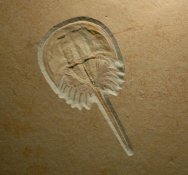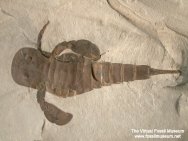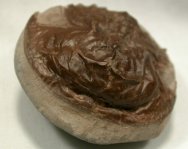Anomalocaridid Fossils
Fossils
of
|
Also see: |
| ||||||||||||||||||||||||||||||||
Anomalocaridid Classification Kingdom Animalia |
The Cambrian Anomalocaridid fossil record mainly comprises specimens from lagerstätten fossil sites in Australia, Canada, China, United States, Canada, Poland and Australia.
from the early Cambrian Chengjiang Maotianshan Shales (525 million years ago), was a . X, from the Burgess Shale (505 million years ago) have been classified as .
Anomalocaridid Evolution
Anomalocarid crown predators of the Cambrian seas
Subphylum Chelicerata Fossils |
||||
 |
||||
Mesolimulus
Horseshoe Crab Class Merostomata Order Xiphosura Jurassic Solnhofen Lagerstätte, Germany |
||||
References and resources and notes:
- Nature - An eye-opening fossil - Ancient predators had vision sharper than modern insects summarizing: Acute vision in the giant Cambrian predator Anomalocaris and the origin of compound eyes
- Schinderhannes (genus) from Solnhofen https://en.wikipedia.org/wiki/Schinderhannes_%28genus%29#/media/File:Schinderhannes.jpg - fair use image of: The one known specimen of Schinderhannes. Credit: Steinmann Institute/University of Bonn > see: https://en.wikipedia.org/wiki/Schinderhannes_%28genus%29 - Schinderhannes bartelsi is an anomalocarid known from one specimen from the lower Devonian Hunsrück Slates. Its discovery was astonishing because previously, anomalocaridids were known only from exceptionally well-preserved fossil beds (Lagerstätten) from the Cambrian, 100 million years earlier. Gabriele Kühl, Derek E. G. Briggs & Jes Rust (2009). "A great-appendage arthropod with a radial mouth from the Lower Devonian Hunsrück Slate, Germany". Science 323 (5915): 771–773.> Great-appendage arthropods, characterized by a highly modified anterior limb, were previously unknown after the Middle Cambrian. One fossil from the Lower Devonian Hunsrück Slate, Germany, extends the stratigraphic range of these arthropods by approximately 100 million years. Schinderhannes bartelsi shows an unusual combination of anomalocaridid and euarthropod characters, including a highly specialized swimming appendage. A cladistic analysis indicates that the new taxon is basal to crown-group euarthropods and that the great-appendage arthropods are paraphyletic. This new fossil shows that features of the anomalocaridids, including the multisegmented raptorial appendage and circular plated mouth, persisted long after the initial radiation of the euarthropods
http://www.sciencemag.org/content/288/5467/841
Also get:
Sirius Passet - The fauna is inevitably compared to that of the Burgess Shale, although it is probably ten to fifteen million years older – 518 vs. 505 Ma (Martin et al. 2[000; Nevadella zone, stage 3 of Cambrian Series 2[2]) – and more closely contemporaneous with the fauna of the Maotianshan shales from Chengjiang. - Peel, J.S. and M. Stein. A new Arthropod from the Lower Cambrian Sirius Passet Fossil-Lagerstätten of North Greenland. Bulletin of Geosciences 84(4). 2009
Fossil
Museum Navigation:
Home Geological Time Paleobiology Geological History Tree of Life Fossil Sites Fossils Evolution Fossil Record Museum Fossils |







